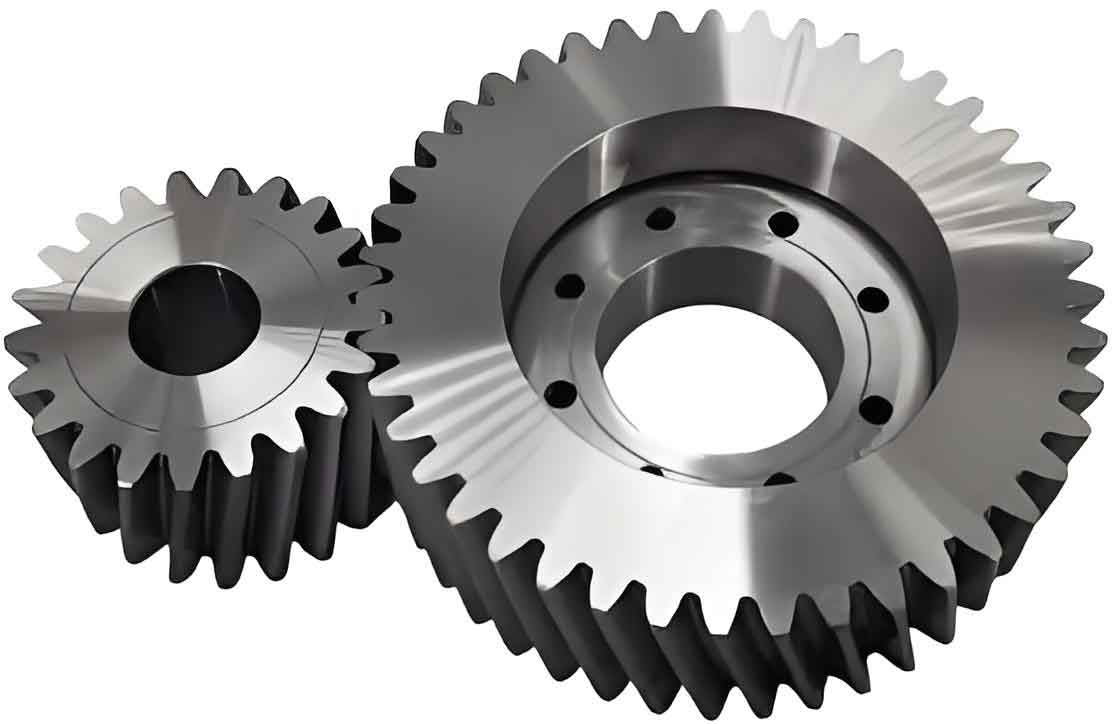
In the design of two-stage cylindrical gear reducers, achieving optimal performance requires balancing multiple conflicting objectives, such as minimizing center distance, maximizing transmission efficiency, and reducing rotational inertia. This study proposes a systematic approach combining multi-objective optimization models with genetic algorithms to address these challenges.
1. Mathematical Modeling of Cylindrical Gear Reducers
The design variables for cylindrical gear reducers include gear parameters and transmission ratios:
$$ \mathbf{X} = [m_{n1}, m_{n2}, z_1, z_2, i_1, \beta]^T $$
Three primary objective functions are established:
1.1 Center Distance Minimization:
$$ F_1 = \frac{1}{\cos \beta} [m_{n1} z_1 (1 + i_1) + m_{n2} z_2 (1 + i_2)] $$
1.2 Rotational Inertia Minimization:
$$ F_2 = J_1 + (J_2 + J_3)\left(\frac{1}{i_1^2}\right) + J_4\left(\frac{1}{i_1^2 i_2^2}\right) $$
1.3 Volume Minimization:
$$ F_3 = \frac{\pi \alpha_{d1}}{4} \left(\frac{m_{n1} z_1}{\cos \beta}\right)^3 (1 + i_1^3) + \frac{\pi \alpha_{d2}}{4} \left(\frac{m_{n2} z_2}{\cos \beta}\right)^3 \left(1 + \left(\frac{i}{i_1}\right)^3\right) $$
| Parameter | Description |
|---|---|
| \( m_{n1}, m_{n2} \) | Normal module (high/low-speed stages) |
| \( z_1, z_2 \) | Pinion teeth count |
| \( i_1, i_2 \) | Transmission ratios |
| \( \beta \) | Helix angle |
2. Multi-Objective Optimization Framework
The weighted sum method converts multiple objectives into a single optimization problem:
$$ \text{Minimize } F(\mathbf{X}) = \sum_{j=1}^3 w_j F_j'(\mathbf{X}) $$
Subject to 19 constraints including:
$$ \sigma_H = 305 \sqrt{\frac{(i+1)^3 K_i T_i}{i b \alpha^2}} \leq \text{[}\sigma_H\text{]} $$
$$ \sigma_{F1} = \frac{1.5 K_i T_i}{b d_1 m_{ni} Y_i} \leq \text{[}\sigma_F\text{]}_i $$
| Parameter | Range |
|---|---|
| Normal module (mm) | 2 ≤ \( m_n \) ≤ 5 |
| Helix angle (°) | 8 ≤ \( \beta \) ≤ 20 |
| Pinion teeth count | 20 ≤ \( z \) ≤ 40 |
3. Genetic Algorithm Implementation
The proposed adaptive genetic algorithm addresses Pareto front diversity and convergence:
$$ \text{Knee Point Distance} = \frac{|\mathbf{A}x + \mathbf{B}y + \mathbf{C}|}{\sqrt{\mathbf{A}^2 + \mathbf{B}^2}} $$
Key implementation steps:
- Initialize population with 200 individuals
- Non-dominated sorting for Pareto front identification
- Knee point detection and neighborhood adaptation
- Differential evolution with crossover probability \( p_c = 0.8 \)
- Mutation probability \( p_m = 0.05 \)
4. Case Study: Automotive Gear Reducer Design
A 9kW cylindrical gear reducer with total transmission ratio \( i = 31.5 \pm 5\% \) was optimized:
| Design | Center Distance (mm) | Efficiency (%) |
|---|---|---|
| Original | 598.5 | 97.2 |
| Single-Objective (Size) | 459.4 | 96.7 |
| Single-Objective (Efficiency) | 469.2 | 97.9 |
| Multi-Objective | 451.1 | 98.1 |
The optimized cylindrical gear parameters achieved:
$$ i_1 = 5.7, \quad z_1 = 20, \quad z_2 = 29, \quad \beta = 18^\circ $$
Validated transmission ratio error: \( \Delta i = \frac{31.45 – 31.5}{31.5} \times 100\% = -0.16\% \)
5. Conclusion
This study demonstrates that multi-objective optimization using genetic algorithms significantly improves cylindrical gear reducer performance compared to conventional methods. The proposed framework reduces center distance by 24.6% while increasing transmission efficiency to 98.1%, proving effective for complex mechanical system design. Future work will explore hybrid algorithms combining particle swarm optimization with machine learning for enhanced parameter search efficiency.
